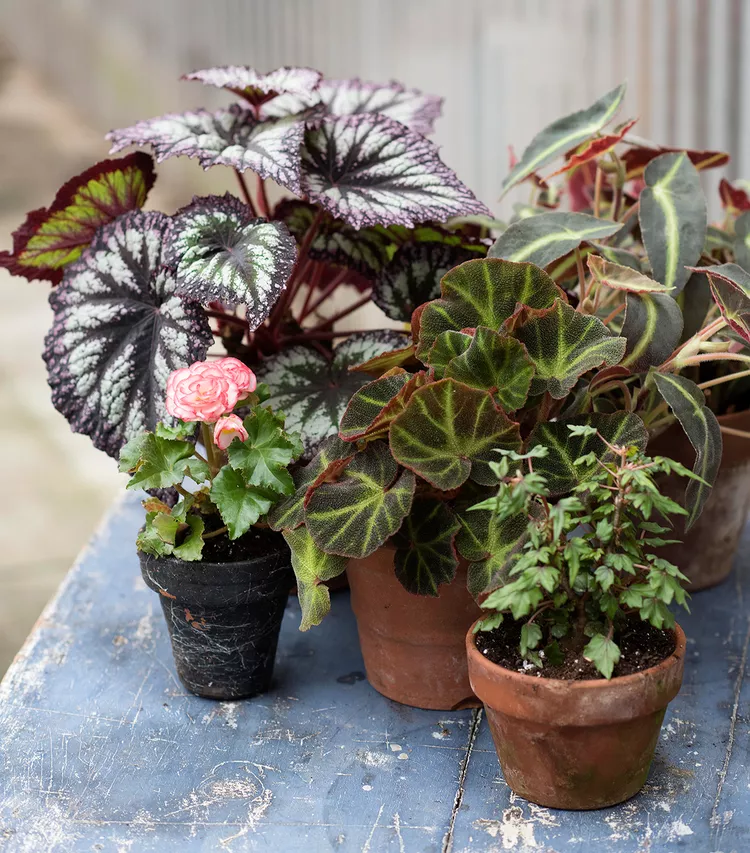8 Begonia Houseplant Care Tips to Keep Your Plants Thriving

Growing begonias indoors is a great way to enjoy this fascinating group of plants up close. Begonias offer tons of diversity in their leaves, flowers, and forms. There are hundreds of species and varieties that offer something for just about everyone. Follow these essential tips to care for begonias indoors so your plants will thrive for many years.
1. Select the Right Begonia Types
Some types of begonias are better suited to indoor environments than others. For example, rex begonias and many species types grow well as houseplants throughout the year with little care. In colder regions with long winters, wax begonias and tuberous begonias tend to do best outdoors during the warmth of the summer. Then, at the end of the season, you can move them indoors to overwinter them. For those who live in desert environments where it's too hot to grow begonias outdoors, you can grow most types of begonias indoors adjacent to windows or under artificial lights but they may be short-lived.
2. Provide Enough Light
For the most part, begonias are shade plants. The vast majority of begonia species and hybrids do well in shade. Many newer types are being grown for increased sun tolerance, but your chances of keeping the plants happy are far greater if they are grown in shade. That said, even shade plants prefer bright, indirect light to do their best, and begonias are no exception. Give begonias growing indoors as much bright indirect light as possible. In northern climates, think about adding artificial lighting with exposures as long as 16 hours a day.
3. Choose the Right Potting Soil
Most begonias hail from tropical regions with year-round moisture and constant warmth, the kind of environments where plants grow fast. In these environments, soils are constantly moist with excellent drainage. So it's no surprise that begonias grown indoors prefer growing conditions as close to their native environments as possible. Before planting begonias, choose a potting mix that contains large amounts of organic matter and has excellent drainage.
4. Be Careful Not to Overwater
Begonias love moisture because their native habitats are humid environments where rain and condensation fall constantly. However, begonias are prone to rotting if they sit in water for too long.
To avoid drowning your begonias and preventing the dreaded root rot, give the plants ample moisture and even better drainage. Indoors, many species, such as rex begonias, can grow in humid terrariums nearly perpetually, but as soon as water begins to pool, rot is usually not far behind. Keep the plants on the wet side for best results but ensure they never sit in water.
5. Feed Indoor Begonias Regularly
The succulent leaves, stems, and flowers of begonias grow quickly, and they need a steady supply of light fertilizer applications to maintain their growth.
For best results, fertilize your begonias once every other week while they are in active growth with a half-strength fertilizer to avoid burning the tender roots of your plants. Organic fertilizers made from fish or kelp emulsions work best to provide a good mix of both macronutrients and micronutrients. In some cases, begonias slow their growth or go dormant during cooler times of the year. When this happens, stop fertilizing the plants altogether until growth resumes.
6. Watch for Pests
Growing and enjoying begonias indoors doesn't prevent the pests that munch on their leaves and steal sap from their stems. Pests, such as mealybugs, spider mites, and aphids, thrive on begonias and can quickly overcome the plants. Check your begonias regularly while watering, deadheading, pruning, or feeding them to spot any evidence of pests before they get out of hand. Be especially diligent in looking under the leaves and in the nooks where leaves join stems, because many pests tend to hide in these places.
7. Stick with Least-Toxic Pesticides
Despite being vigilant, you may end up with a difficult pest problem on a begonia. If rinsing off the pests or removing them with your fingers hasn't worked, an organic pesticide, such as neem oil, pyrethrin, and insecticidal soap may be your next option. Follow the directions on each product exactly and never over-use chemicals.
8. Keep Moves to a Minimum
It might seem obvious, but most plants don’t move around much once established. Avoid moving plants around to various locations in your house during a given season, especially from darker to brighter locations. Begonias can be sensitive to big changes, so they prefer to stay put in a given location for as long as possible, acclimating to the ambient humidity and light exposure. Whenever possible, position your plants where you want them and leave them there.